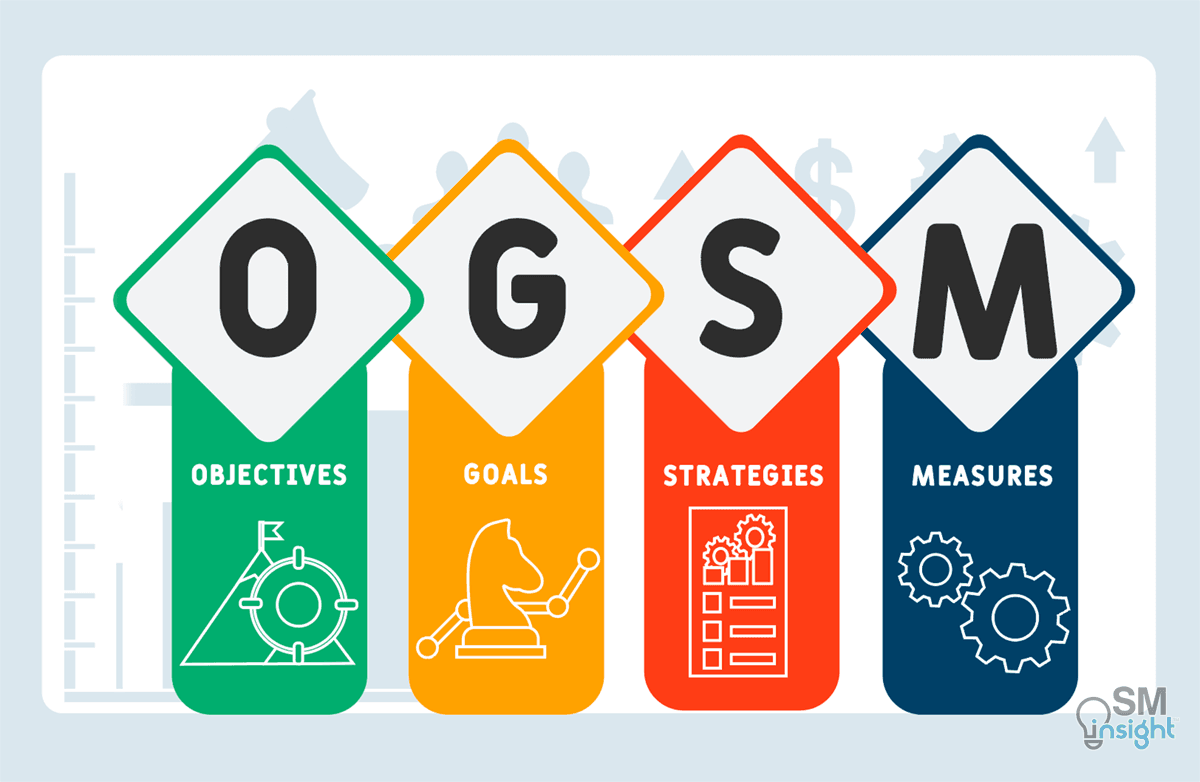Left unchecked, market forces continually conspire to deplete profits. Good business strategies can counteract those tendencies but are notoriously challenging to formulate and execute. To be successful, an organization must gain agreement on priorities and essential decisions and ensure it is prepared and willing to act on them once adopted.
Communicating the strategy is equally challenging. How does a company ensure its employees understand and own the strategy, feel they are vital to its success, and take personal responsibility for it?
To bring this about, organizations must take people into confidence. They must know the relationship of their work to the business as a whole. In most organizations, however, there exists a severe disconnect between strategy and day-to-day operations:
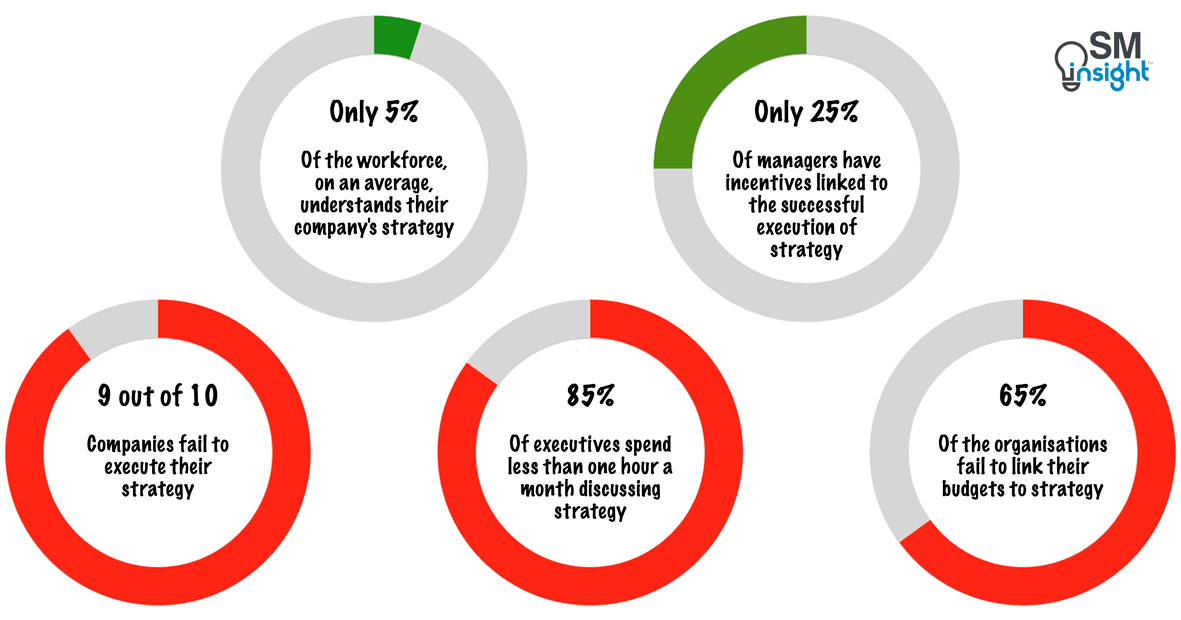
This is where OGSM (Objective, Goals, Strategies, and Measures) helps.
OGSM Framework is a written and easily communicated statement of an organization’s objectives, goals, strategies, and measures—a complete, structured, one-page business plan that aligns and transparently communicates organizational priorities and metrics.
Creating OGSM allows an organization to clearly define its objectives (both in purpose and financially), crystallize key strategies & initiatives, assign owners and due dates, and develop a one-page living document that serves as a roadmap for all future planning and reviews.
Because OGSM allows only one page of space, it forces organizations to think: What are the few key things we should do? And, more importantly, what are all the things we don’t do (anymore)?
Origin of OGSM
OGSM originated from work processes developed during the occupation of Japan following its Allied surrender in 1945. It was later adopted in car manufacturing assembly lines like Honda in the 1950s before eventually appearing in the U.S. [1]
The concept originated from multinational, top-down management thinking because so much of post-war Japan’s industry was overseen by Allied countries. Peter Drucker’s Management by Objectives has also had a key influence in shaping OGSM as we know it today.
Several large corporations, including Fortune 500 companies like Coca-Cola, Procter & Gamble, KPN, Reckitt Benckiser, Honda, Mars, MetLife, and Triumph International, have used and benefitted from OGSM.
Components Of OGSM
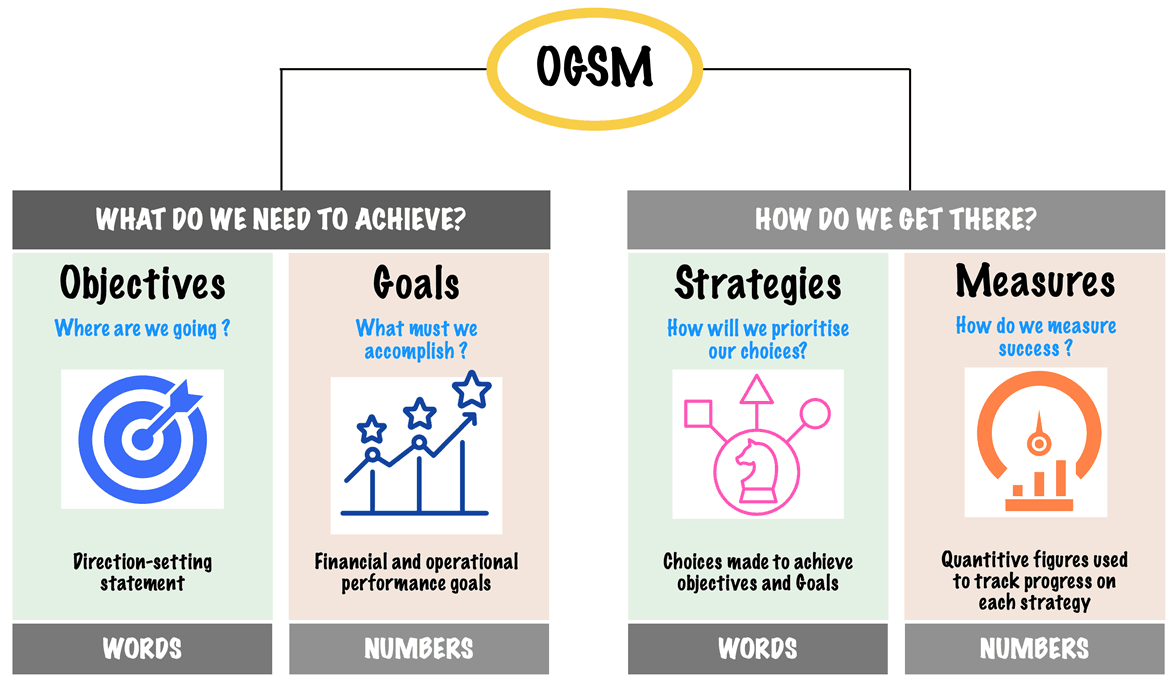
Objective
An Objective is a statement that sets the direction for the organization’s next three to five years. It describes the business’s ambition and answers the question: What are we trying to achieve?
The objective defines the playing field and the rules for winning. It serves as a constant and meaningful reminder of what success looks like in the future. An effective objective statement should not be generic or easily adoptable by others; it must be a customized, business-specific view of where the organization is headed.
Characteristics of a Good Objective
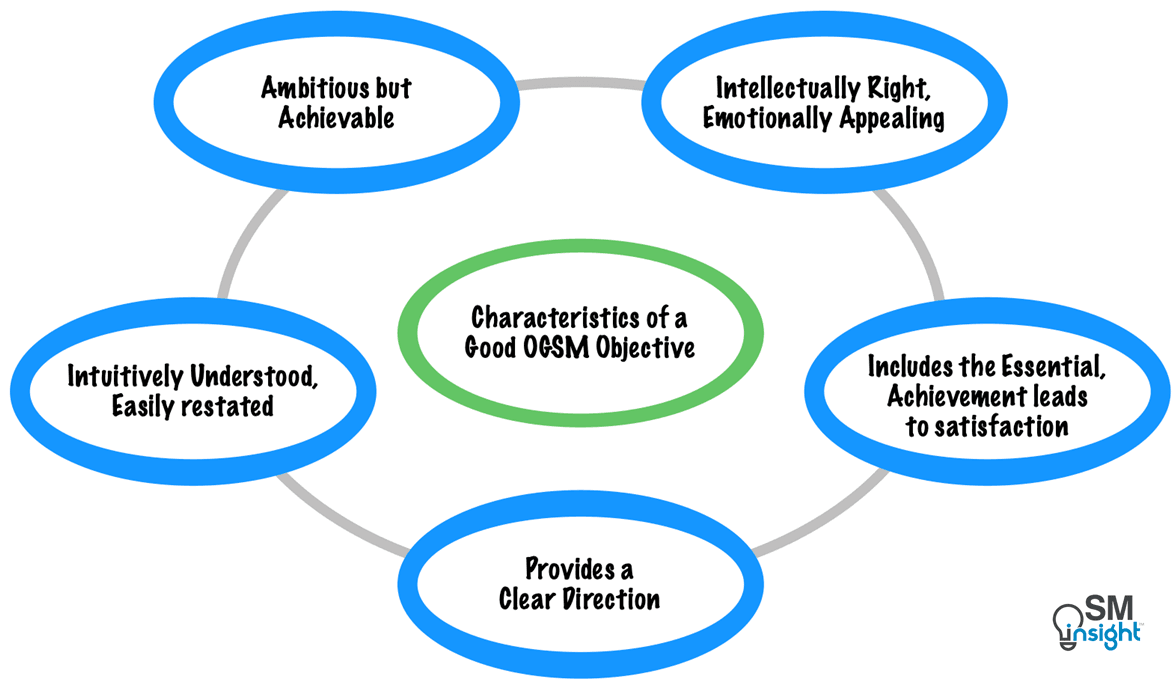
A good objective must have the following characteristics [3]:
- Ambitious But Achievable: When setting objectives, it is better to err on the side of ambition than make them seem achievable. If the plan is ambitious, it inspires people to think creatively, often leading to surprising, inspiring, and compelling new directions.
Objectives that are too achievable lack inspiration. They either require people to do exactly the same or just a little more than what’s been done. - Intellectually Right And Emotionally Appealing: Being ‘intellectually right’ means the objective must align with an organization’s higher goals and be compatible with its strengths, weaknesses, opportunities, and threats (SWOT).
‘Emotionally appealing’ is about inspiration. The objective should be formulated to motivate employees to contribute.
For example, in the 1960s, during the peak of the space race, NASA adopted an ambitious objective: “Put the first man on the moon, and then return the crew safely.” It is said that one day, when President Kennedy visited NASA, he asked a janitor what he was doing. The man cleaned windows, but his proud response was: ‘Sir, I’m helping to put a man on the moon.’ [3]
- Intuitively Understood And Easily Restated: a good objective must be clear and straightforward, making it easy for team members to grasp and explain the goal to others. The objective’s intuitive nature must ensure everyone understands the focus and can consistently reiterate it in meetings and communications.
- Must Include Essential Elements And Lead To Complete Satisfaction: the objective must include all essential elements (the ‘need-to-haves’) and exclude those that don’t matter as much in achieving results (the ‘nice-to-haves’).
These aspects can be different for each organization. For example, sustainable energy could be a ‘need to have’ for one energy supplier but a ‘nice to have’ for others. The important thing here is that people are clear about what they agree on together.
A good way to determine if something is a ‘need to have’ or a ‘nice to have’ is to use the following question: ‘Suppose we do reach the objective, except for this one element, would we be truly satisfied?’ Depending on the answer to this question, the element should either be added to the objective or parked for later. - Provides Clear Direction (What-By-How): the what-by-How approach is a helpful method for setting objectives in OGSM. According to it, well-formulated objectives, strategies, and actions must always consist of a ‘What’ element and a ‘How’ element.
A good example of an objective would be “Improve customer satisfaction by 20% within the next 12 months (what) through enhanced customer support, collecting and acting on feedback, training programs, and follow-up systems (how).”
Goals
In OGSM, goals define success in terms of numbers over a period of three to five years. They are usually financial and/or operational and make the objective measurable. They must be strategic, define the organization’s financial health, and guide its strategic choices.
Goals must answer the question “What do we want to achieve?” in terms of critical targets and statements. They help people determine whether they are still on track and ensure that all stakeholders share the same interpretation of the objective.
In contrast to other management methods, OGSM goals are “coordinates” of the point on the horizon that an organization must reach. This makes reaching them an all-or-nothing approach. Choosing clear goals and making them SMART is important (Specific, measurable, acceptable, results-oriented, and time-bound). [4]
Strategies
Strategies are explanations and descriptions of specific choices that the organization makes in its plan to achieve the objective (and the goals). It guides the work activities and resource allocation across the organization.
Strategies are implemented through initiatives and structured work plans called charters that specify the deployment and distribution of employees, time, and financial resources. They tighten the choices needed to deliver the objective and goals and win the market.
Strategies must be written in clear, complete language. It is important to restrict them to an essential few so the organization gets more out of handling them well vs. barely managing many strategies.
By design, the OGSM framework restricts the number of strategies because it requires organizations to spell out all their strategy in a one-page document.
When choosing strategies, focusing on the objective (the bigger picture) rather than the goal is helpful. A goal is only the starting point for a strategy, and setting it purely based on a goal can be suboptimal, as a strategy is supposed to work for multiple goals.
This is why the OGSM model does not lock goals and strategies into a one-on-one relationship.
How to Test a Strategy
To ensure the chosen strategies are clearly and well-defined, consider how they fair in each of the following five Ss:

- Specific: Strategy should be articulated as ‘What-by-How’ so that it is obvious what the strategy aims to achieve and how. It must also be simple enough for everyone to understand.
- Selective: Being selective helps improve the organization’s focus and determine whether it has made a clear decision regarding the ‘How’ component. It is more about choosing what not to do due to strategic choice.
- Sustainable: Only a few factors are within the organization’s circle of control. To succeed, strategy must be based on what an organization can control and must sync with its strengths. To be sustainable, the strategy must solve something important—like providing a long-term advantage over the competition, responding to customers’ unmet needs, or addressing a significant problem.
- Synchronized: An organization’s strategies must unite to form a stronger whole. Strategies that work well independently but counteract each other need to be revisited. For example, the marketing department cannot build a brand to command higher prices when the sales team is looking to dump inventory at discounts to reduce working capital.
- Sufficient: this is a test to make a critical estimate of whether the chosen objective and the goals can be reached with all the strategies combined. What does the gut feeling of those who know a lot about the organization and the market say? If the collective sense is that the strategies are insufficient, another strategy should be added.
Measures
Measures are numbers that determine the organization’s progress toward delivering its strategy. No more than two or three measures must be linked to each strategy. Measures must convey whether the strategy is effective and has the desired impact. They are also crucial to making decisions regarding necessary adjustments mid-course.
In the book The One-Page Business Strategy [3], authors Marc Eck & Ellen Leenhouts suggest splitting measures into two parts: Dashboard and Actions.
A dashboard is a quantitative translation of all the major elements of the strategy. It helps monitor whether the chosen strategy has moved the organization forward, both during its execution and at its conclusion. Each strategy should have its own dashboard. It provides an overview of whether the ‘How’ component is being carried out and shows whether that ‘How’ is helping realize the ‘What.’
Actions translate each strategy into concrete steps formulated as ‘What-by-How.’ They also specify who performs each action and the due date/deadline, helping ensure actions are implemented.
How to Develop an OGSM
Because OGSM for a given organization must be captured on a single sheet of paper or screenshot, the resulting brevity brings clarity, tracking, and visibility. Everyone, from executives to project teams, can use this document to manage work activities.
The net result is increased productivity in how an organization manages the work and the work they do. The single-page OGSM format is shown below:
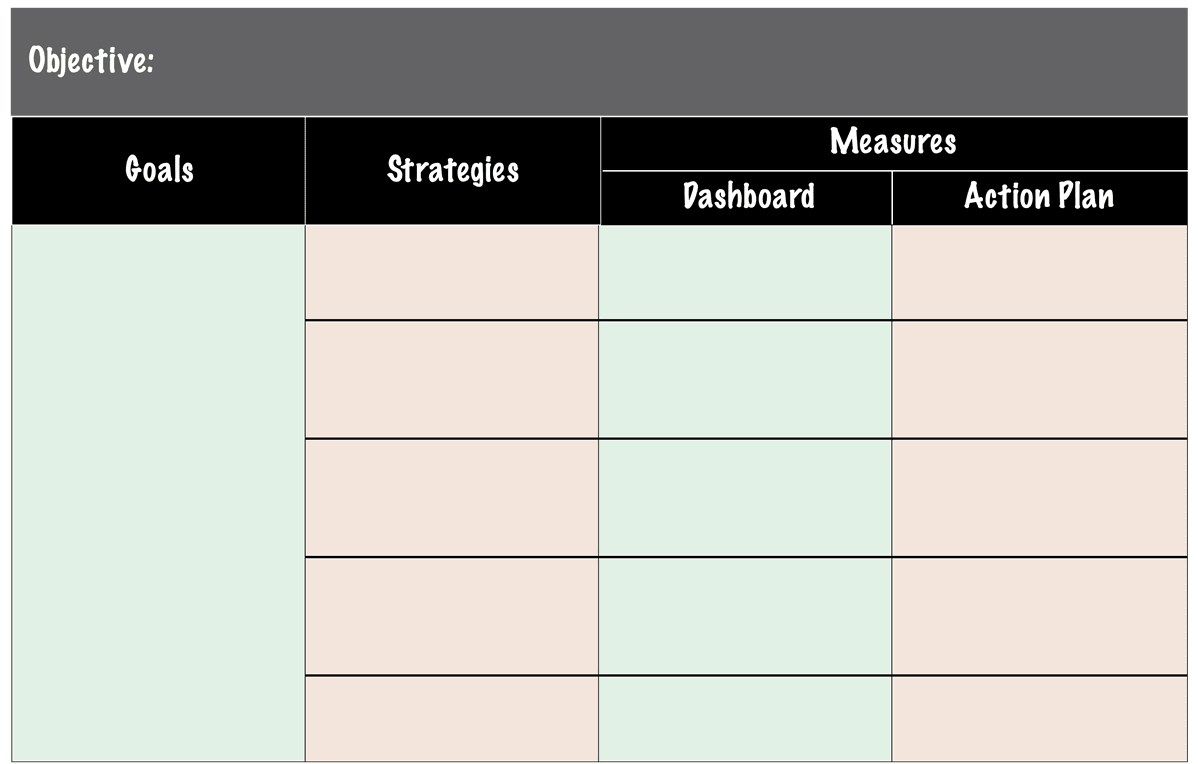
The following step-by-step approach will allow an organization to define objectives, crystallize key strategies and initiatives, assign owners and due dates, and build a one-page living document that can be the road map for all future planning reviews:
1. Gather External Data
Understand the reality of the marketplace. Identify trends, critical expectations, and unmet needs. Also, study the performance of internal functions interacting with customers to gather data and better understand how customer value is delivered.
2. Gather Internal Data
Interview the management and extended leadership team. Questions must be designed to identify opportunities within categories like growth, productivity, and people. By the end of the interviews, the organization must be clear about what works well and the areas for improvement.
3. Facilitate Executive Overview And Debriefing Session
Data collected in steps 1 & 2 are analyzed, and a comprehensive and detailed summary of the findings is presented to the leadership team. This includes the macro trends, major positive themes, and opportunities for organizational improvement. This review session is a brutally honest assessment of an organization’s current state.
4. Define The Objective Statement
Based on market data and internal feedback, the leadership team collaboratively develops an objective statement that sets the company’s direction for the next three to five years. This statement is a customized, business-specific view of where the organization is headed.
5. Define Goals
With the objective statement as the guide, the leadership team develops a three-to-five-year financial outlook. It determines whether all team members are aligned with the same expectations, asking each member, “What are the headwinds and tailwinds facing the company?” and “Are the financial goals achievable?” At this point, the team addresses any gaps between expectations and financial realities.
6. Develop Strategies
With the objective and goals determined, the leadership team develops five to six overarching strategies for the organization and their respective initiatives. These critical choices address the performance gaps identified from internal and external feedback and observations.
Five strategic directions crop up repeatedly in most management methodologies:
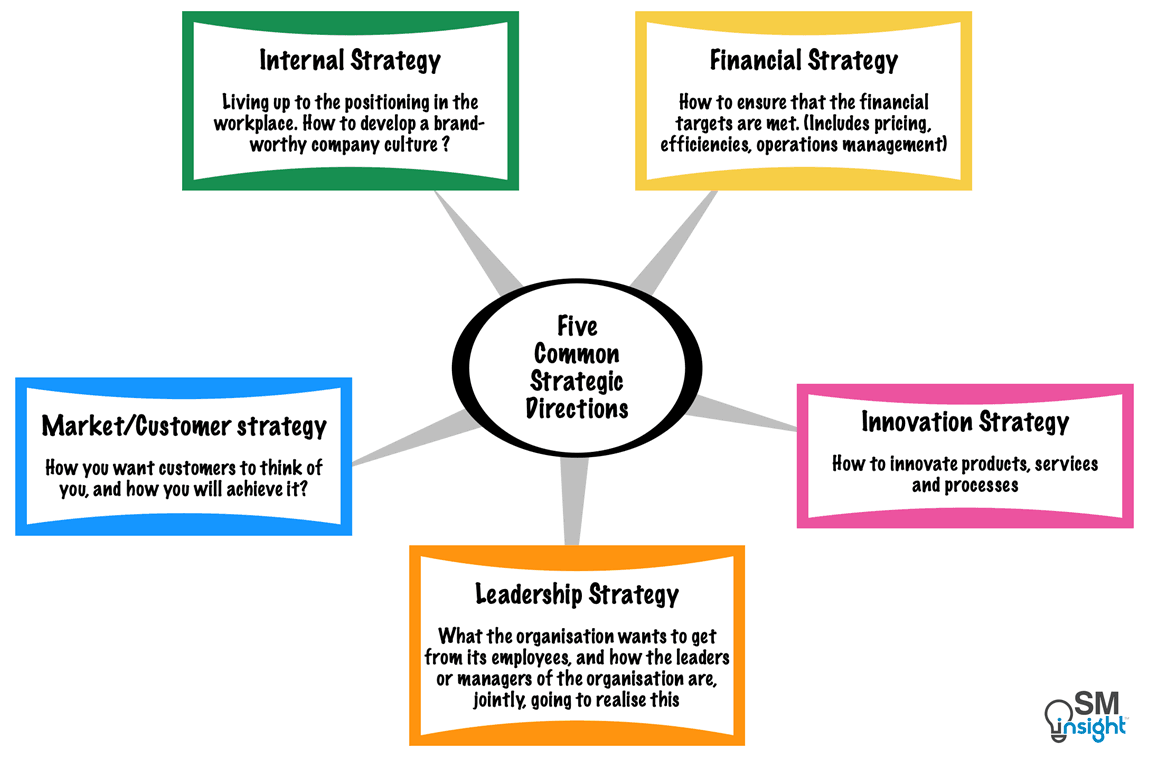
While all five need not be part of OGSM, these five directions are a checklist to ensure every relevant direction is consciously considered.
7. Develop Measures For Each Strategy
Measures involve developing a dashboard measure and an action plan(s).
Dashboard measures must be SMART (Specific, Measurable, Acceptable, Results-oriented, and Timely). Wherever possible, it is preferable to use measurements the organization is already familiar with, as they are easily communicated and understood.
It is better to know if a strategy is on track with 80% accuracy using an existing measure rather than devising a new one for 100% accuracy. The dashboard also provides objective criteria for go/no-go decisions and corrective measures to be taken to make adjustments along the way.
When defining an action plan, one must be selective about the number and type of actions. Eliminate the ‘nice to do’ actions and only retain those truly needed for successful strategy execution. Add names and deadlines to all actions to help visualize how the workload is distributed and make necessary modifications or request external help.
Organizations must critically access activities that are already part of routine processes. OGSM is intended for making choices; this means filtering out all those activities that do not meaningfully contribute to the strategy.
8. Develop the Final OGSM
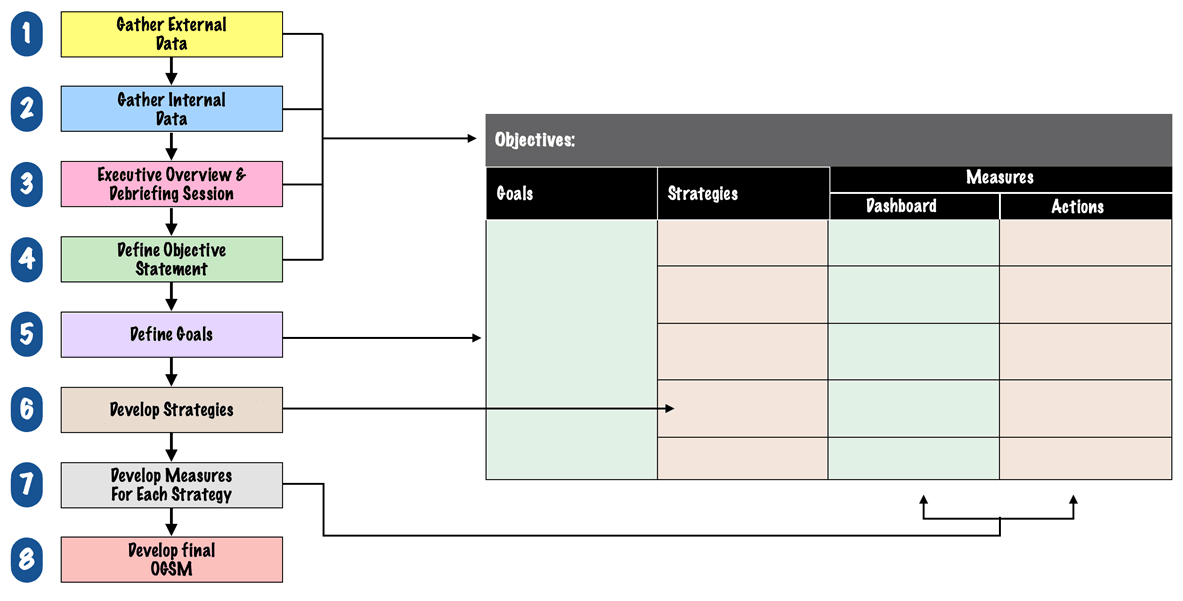
Finally, the team gathers all the information completed in the first seven steps and builds a one-page OGSM. The resulting document communicates and aligns the rest of the organization with the business’s critical priorities. Developed collaboratively and based on the business’s needs, the OGSM can now guide all future planning sessions.
Example of an OGSM
The example below is adapted from the book The One-Page Business Strategy [3] and is a fictional OGSM developed for the automobile brand Jeep.
The starting point for developing the OGSM is as follows: Jeep needs a plan to stimulate sales of its four-wheel-drive cars. Its brand name has become more of an indication of the type of car than of the brand itself.
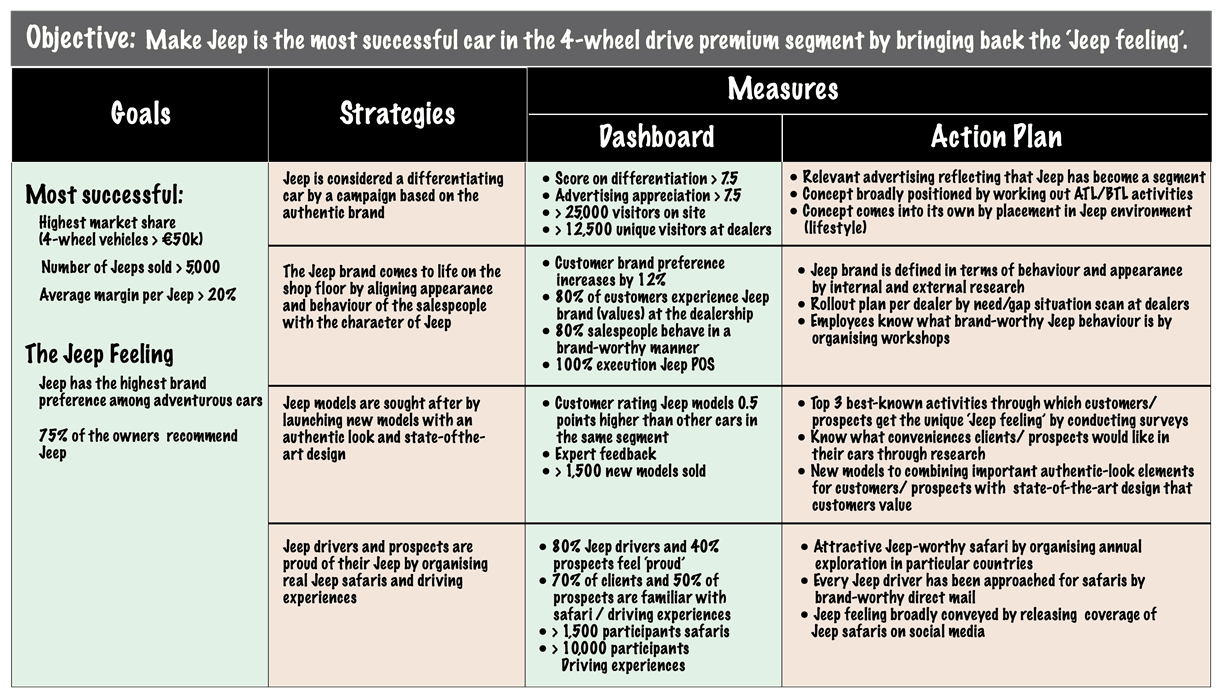
How to Cascade OGSM Within the Organization
Cascading is the process by which an organization-wide OGSM is translated into divisions, departments, and people. This ensures that everyone, at every level, contributes to the organization’s objective.
When done right, cascading converts the organization’s OGSM process into a conscious, concerted, and broadly supported movement toward achieving the overall objective. OGSMs cascade to any desired level. On average, there are three to four levels of OGSMs linked to drive alignment deep into the organization:
![How OGSMs Cascade (Source: Developing, Aligning, And Deploying Strategy, ArchPoint [1])](https://strategicmanagementinsight.com/wp-content/uploads/How-OGSMs-Cascade.png)
Vertical Cascading
In vertical cascading, a specific strategy from the organization’s OGSM is elevated to a department or team objective, and the dashboard measures are elevated to goals.
The department or team then develops the strategies and measures for the underlying OGSM, which are included as actions in the main OGSM, along with responsible persons and deadlines.
For example, in a tech company’s OGSM plan, if one of the strategies is to “Enhance user engagement by developing a new mobile app,” this becomes the objective for the mobile app development team, and the associated measures (such as complete app development by Q3, conduct thorough QC tests, etc.) are elevated to Goals.
Strategies would include statements such as “leverage AI to speed up design,” “implement new features based on user feedback,” etc. Measures could be “development milestones completed on time,” “100% QA test pass rates”, etc.
This way, the mobile app development team is solely focused on building the new app, and its efforts are aligned with the company’s goal of increasing user engagement.
Horizontal Cascading
Horizontal cascading is suited when a department or team plays a role in the entire organization’s OGSM. Objectives and expected contributions are specified for each department or team.
In most cases, only the ‘How’ part is adapted; the ‘What’ part remains unaltered. This also applies to goals, strategies, and measures. Those parts where the department or team has no influence are removed, and department-specific strategies are added if needed.
Horizontal cascading clarifies each department’s contribution to the business—something that has not always been clear or possible to accomplish without OGSM.
Mixed Cascading
In practical situations, two types of cascading are often mixed. The line departments might cascade vertically so that one specific department (such as Sales) succeeds with a particular strategy, whereas the staff departments (such as Finance) might cascade horizontally.
However, regardless of the type, by cascading OGSM, the organization makes its strategic direction clear to everyone. People also become aware of their contribution, which is critical to the organization’s success.
Testing an OGSM
Once developed, OGSMs must be tested for alignment, achievability, adequacy, accuracy, and ambitiousness. The following questions in each of these areas help improve an organization’s OGSM:
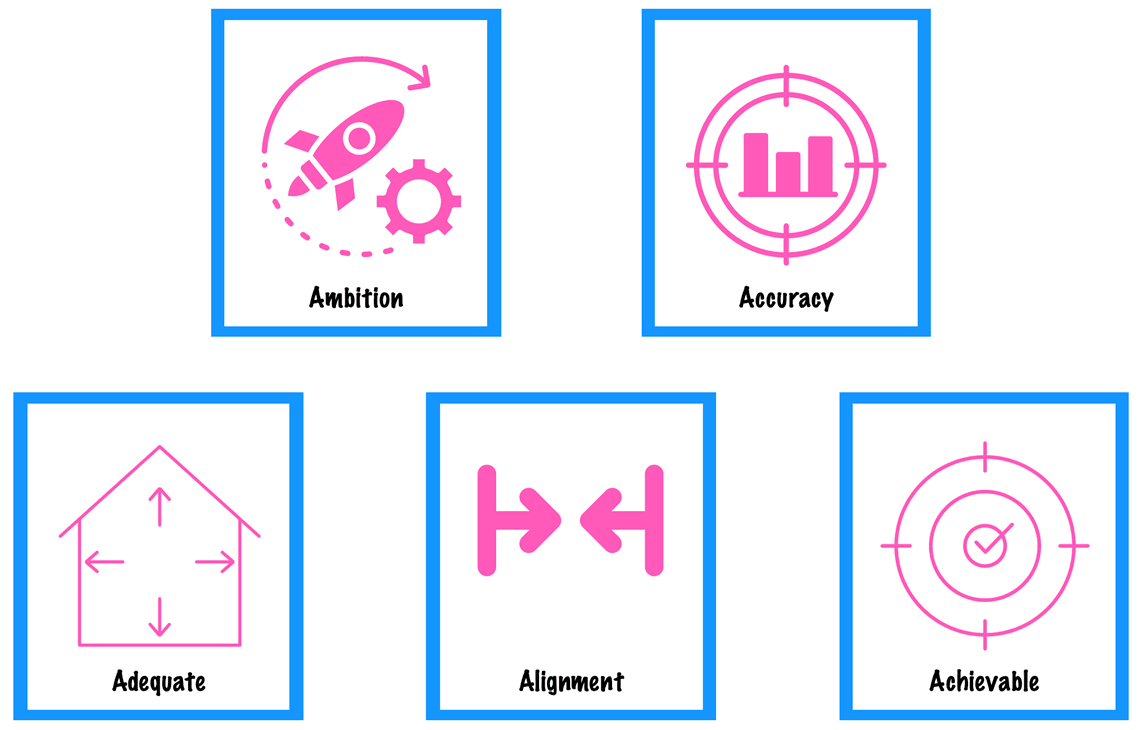
Alignment: Is it clear how the objectives and goals will be achieved by executing strategies and initiatives? Do the Goals and Measures reflect how management tracks the business’s success? Is there a transparent linkage between the OGSM at the top level and the OGSM one step down (both in language and strategic intent)?
Achievable: Does the organization have the competency and capability to achieve the direction the OGSM has set? In other words, will the OGSM be a success or failure based on the honest assessment of the team’s ability to deliver it? Are factors such as market dynamics, competition, company commitment, etc., considered?
Adequate: Are the Strategies defined in the OGSM sufficient and specific enough to deliver the Objectives and Goals? Are they detailed and have enough muscle to create high confidence that they are the best choices to deliver the plan?
Accurate: Do the Strategies communicate the explicit choices the organization is making? Does it clarify what we will do and (more importantly) what we will not do?
Ambitious: Do strategies stretch and push the organization to new levels of results? Do objectives and goals have the right level of ambition to move the organization in the direction it aims?
Common OGSM Pitfalls
The following are the common pitfalls that deter an organization from making the most of its OGSM:
- The OGSM is generic, and its language is such that it can be adapted by almost any organization.
- The organization is fixated on the methodology rather than moving forward and executing, focusing less on the template’s bureaucracy and more on execution.
- The focus is diluted by spreading attention across too many strategies.
- More time is spent on wordsmithing instead of moving toward execution.
- Planning fails to consider external perspectives, such as market trends, customer needs, competition, and other external influences.
- The organization is unwilling to change how it manages the business. OGSM management routine requires discipline and consistency, which most organizations lack in their planning process.
- The organization believes that everyone, from the top down, needs an individual OGSM. Instead, business priorities should be linked to performance management, and the OGSM should be linked to each employee’s work.
Sources
1. “Fascinating statistics on why corporate strategy breaks down.” ArchPoint Consulting, https://archpointconsulting.com/strategy/fascinating-statistics-on-why-corporate-strategy-breaks-down. Accessed 05 Apr 2025.
2. “OKRs and OGSM: What’s the Difference?”. What Matters, https://www.whatmatters.com/resources/ogsm-vs-okr-whats-the-difference. Accessed 05 Apr 2025.
3. “One Page Business Strategy: Streamline Your Business Plan in Four Simple Steps.” Marc Eck and Ellen Leenhouts, https://www.amazon.com/dp/1292009624?ref. Accessed 07 Apr 2025.
4. “Sweeping the Floor or Putting a Man on the Moon: How to Define and Measure Meaningful Work.” Frontiers in Psychology, https://www.ncbi.nlm.nih.gov/pmc/articles/PMC5626826/. Accessed 06 Apr 2025.
5. “The Ultimate Guide To S.M.A.R.T. Goals”. Forbes, https://www.forbes.com/advisor/business/smart-goals/. Accessed 06 Apr 2025.
6. “ArchPoint OGSM Model”. ArchPoint Consulting (Amy Lazarus), https://archpointconsulting.com/strategy/strategic-planning-that-works-the-archpoint-ogsm-model. Accessed 05 Apr 2025.
7. “Objectives and Key Results (OKR)”. Strategic Management Insight, https://strategicmanagementinsight.com/tools/objectives-key-results/. Accessed 12 Apr 2025.

